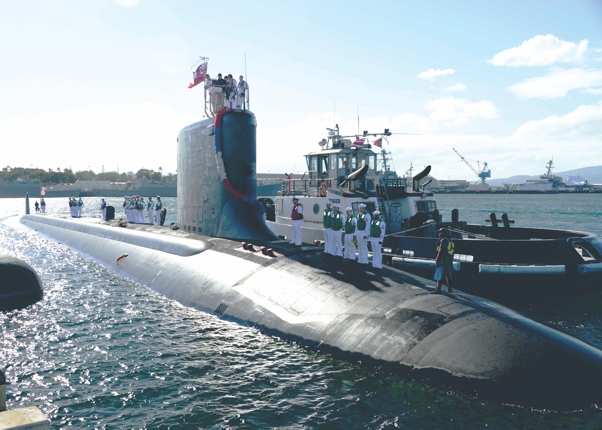Naval reactors in need of redesign
DOI: 10.1063/PT.3.2779
For its next-generation submarines and aircraft carriers, the US Navy should develop nuclear reactors that do not require highly enriched uranium (HEU) fuel. That recommendation comes from a new report by a task force commissioned by the Federation of American Scientists (FAS), a think tank on nuclear defense issues. Beginning no later than fiscal year 2017, Congress should increase funding for the Office of Naval Reactors program at the Department of Energy, says the FAS report. That deadline would provide sufficient time to develop a low-enriched uranium (LEU) power plant for boats that will succeed today’s Virginia-class attack subs.

The Virginia-class attack submarine USS Mississippi arrives in Pearl Harbor. Office of Naval Reactors officials say the development of a reactor fueled by low-enriched uranium for the next-generation attack sub to succeed the Virginia-class would require 10 to 15 years and $2 billion.
US NAVY/STEVEN KHOR

Construction of the next-generation boats is expected to begin around 2032. The Virginia-class subs are the first series to have reactors that don’t require refueling for the ships’ lifetimes, which are set for 33 years.
The report, Naval Nuclear Propulsion: Assessing Benefits and Risks, also recommends that at the 2016 nuclear security summit the US and UK declare their intention to investigate the feasibility of opening their naval fuel cycles to international safeguards.
The use of HEU for warship propulsion reactors not only poses the risk of the fuel’s diversion to weapons use during fuel fabrication and transport, but also creates a potential cover for nonweapons states such as Iran to produce weapons-grade material. Iranian officials have discussed enriching uranium to 60% uranium-235 for naval use. HEU is considered to be at least 20% 235U. Weapons-grade uranium is generally considered to be 80% or more 235U. A loophole in the Nuclear Non-Proliferation Treaty exempts HEU produced for naval propulsion from the scrutiny of inspectors from the International Atomic Energy Agency.
Sowing the seeds
No one from the Office of Naval Reactors responded directly to the FAS report; instead, officials there pointed to the office’s January 2014 report to Congress on the feasibility of LEU power plants. That document stated that while a suitable LEU reactor might be built, its development would require 10 to 15 years and $2 billion in additional funding. At least another 10 years would be required to deploy it on ships.
Brazil and other nations that aspire to build nuclear-fueled warships present another proliferation risk: “If states want their own nuclear navies they will likely want or need to have their own enrichment plants, thus sowing the seeds for potential future nuclear proliferation, or at least greatly challenging efforts to safeguard many more plants,” the report states.
The US Navy has the world’s largest nuclear-powered fleet, comprising 10 aircraft carriers and 72 submarines. Because of its high neutron flux, HEU allows for the building of compact reactors and thus provides a strong incentive for the navy to continue using it. The US and UK navies are believed to use weapons-grade uranium, enriched to more than 90%, according to the report. India’s and Russia’s navies also use HEU, though their enrichment level likely isn’t as high.
China is believed to use LEU in its nuclear-powered subs. And France’s navy converted from HEU to LEU fuel beginning in the 1990s.
In a paper commissioned by the FAS task force, Alan Kuperman of the University of Texas at Austin said the navy would likely require nearly the same time and resources to develop either an advanced HEU-fueled or an LEU-powered reactor for the replacement subs.
Globally, naval propulsion consumes an estimated 3 metric tons of HEU annually, enough for more than 100 weapons, according to the Kuperman paper. Navies account for about three-quarters of total worldwide usage of HEU.
Physics issues
A second FAS-commissioned paper, by Alireza Haghighat of Virginia Tech and colleagues, cautioned of unintended consequences from using LEU-fueled reactors. Two separate physics issues with LEU cores—the addition of a fuel effect in the reactivity feedback mechanism and xenon poisoning—would necessitate operator intervention, such as the withdrawal of control rods, when the reactor power changes. Neither issue occurs with an HEU core, the Haghighat paper states, so no operator intervention is required.
An LEU reactor of size and power comparable to the HEU version would likely require refueling, which presents the risk of radiation exposures and accidents, warn Haghighat and colleagues.
The FAS report recommended further in-depth examinations of the issues raised in the Haghighat paper.
More about the Authors
David Kramer. dkramer@aip.org
